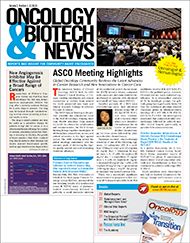Publication
Article
OBTN
New Angiogenesis Inhibitor May Be Effective Against a Broad Range of Cancers
Researchers at Children's Hospital Boston say that they have developed the first oral, broad-spectrum angiogenesis inhibitor that may offer a potential nontoxic therapy for a wide range of cancers. The drug was formulated through nanotechnology and has shown promising anticancer results in mice.
Click here to view as PDF.
Researchers at Children’s Hospital Boston say that they have developed the first oral, broad-spectrum angiogenesis inhibitor that may offer a potential nontoxic therapy for a wide range of cancers. The drug was formulated through nanotechnology and has shown promising anticancer results in mice.
Nature Biotechnology
The drug is called Lodamin and may be useful as a preventive therapy for patients at high risk for cancer or as a chronic maintenance therapy for a variety of cancers, preventing tumors from forming or recurring by blocking the growth of blood vessels to feed them. Lodamin may also be useful in other diseases that involve aberrant blood-vessel growth, such as age-related macular degeneration and arthritis. Findings were published on-line on June 29 by the journal .
Developed by Ofra Benny, PhD, Lodamin is a novel slow-release reformulation of TNP-470, a drug developed nearly two decades ago by Donald Ingber, MD, PhD. In clinical trials, TNP-470 suppressed a surprisingly wide range of cancers, including metastatic cancers, and produced a few complete remissions. Trials were suspended in the 1990s because of neurologic side effects that occasionally occurred at high doses, but it remains one of the broadest- spectrum angiogenesis inhibitors known.
Lodamin appears to retain TNP-470’s potency and broad spectrum of activity, but with no detectable neurotoxicity and greatly enhanced oral availability. While a number of angiogenesis inhibitors, such as Avastin, are now commercially available, most target only single angiogenic factors, such as VEGF, and they are approved only for a small number of specific cancers. In contrast, Lodamin prevented capillary growth in response to every angiogenic stimulus tested. Moreover, in mouse models, Lodamin reduced liver metastases, a fatal complication of many cancers for which there is no good treatment.
“The success of TNP-470 in phase I and II clinical trials opened up antiangiogenesis as an entirely new modality of cancer therapy, along with conventional chemotherapy, radiotherapy and surgical approaches,” says Dr. Ingber, now co-interim director of the Vascular Biology Program at Children’s Hospital Boston.
TNP-470 was first reformulated several years ago by Ronit Satchi-Fainaro, PhD, who attached a large polymer to prevent it from crossing the blood-brain barrier. That formulation, Caplostatin, has no neurotoxicity and is being developed for clinical trials. However, it must be given intravenously.
Dr. Benny took another approach, attaching two short polymers (PEG and PLA) to TNP-470. Experimenting with polymers of different lengths, she found a combination that formed stable, “pompom”- shaped nanoparticles known as polymeric micelles, with TNP-470 at the core. The polymers (both FDA-approved and widely used commercially) protect TNP-470 from the stomach’s acidic environment, allowing it to be absorbed intact when taken orally. The micelles reach the tumor, react with water and break down, slowly releasing the drug.
Notably, Lodamin accumulated in the liver without causing toxicity, preventing liver metastases and prolonging survival. “This was one of the most surprising things I saw,” says Dr. Benny. “When I looked at the livers of the mice, the treated group was almost clean. In the control group you couldn’t recognize the livers—they were a mass of tumors.”
TNP-470 itself has an interesting history. It was derived from fumagillin, a mold with strong antiangiogenic effects that Dr. Ingber discovered accidentally while culturing endothelial cells (the cells that line blood vessels). Dr. Ingber noticed that in certain dishes—those contaminated with the mold—the cells changed their shape by rounding, a behavior that inhibits capillary cell growth. Dr. Ingber cultured the fungus, disregarding lab policy, which called for contaminated culture to be discarded immediately. “It’s been an evolution,” says Dr. Benny, “from fumagillin to TNP-470 to Caplostatin to Lodamin.”
Lodamin and Caplostatin have been optioned for clinical development by SynDevRx, Inc., a Cambridge, MA—based biotechnology company. Dr. Benny continues to study Lodamin’s effects in other animal models of cancer, and in macular degeneration with Robert D’Amato, MD, PhD, in the Vascular Biology program.
This article was written from materials provided by Children’s Hospital Boston.
Benny O, Fainaru O, Adini A, et al. An orally delivered small-molecule formulation with antiangiogenic and anticancer activity.
2008;26:799-807.
Nature Biotechnology,
